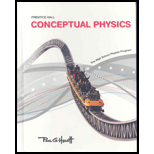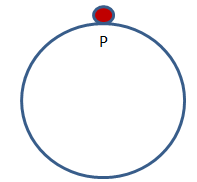
Concept explainers
Distinguish between unstable, stable, and neutral equilibrium.
To Distinguish: Among the unstable, stable and neutral equilibrium.
Explanation of Solution
Introduction:
When body is said to be in equilibrium, there is no change in the state of the body. Vector sum of the all the forces acting on body is zero. Equilibrium can be classified as:
- Stable equilibrium
- Unstable equilibrium
- Neutral equilibrium.
Stable equilibrium:
When body is in stable equilibrium, force/torque acting on the body is in the opposite direction to its displacement when body is moved from its equilibrium point.In stable equilibrium, body always tries to attain the stable equilibrium point. In this case net torque acting on the body is zero.Below figure shows the marble in circular vessel. Point O is the equilibrium point. When marble moved, force is acting on the marble in the reverse direction to its displacement so that it again reaches to its initial position O.Therefore, in this case acceleration of marble is zero.

Unstable equilibrium:
In case of unstable equilibrium, when body is acted upon by the force, it accelerates in the direction of displacement. The net force acting on the body is in the direction of the force. Consider the following figure. Initially marble is at point P. When force isapplied on marble from any direction it slides down. So, in this case, the net force acting on the marble is in the direction of the displacement. In this case, marble accelerates in the downward direction.

Neutral equilibrium:
Neutral equilibrium is the state where equilibrium does not depend on the displacement of the body. So, after the displacement, body remains in the state of new position. Consider the marble from below figure. Marble is at rest initially. When force is applied on marble, displacement of the marble in the direction of force and it will not come to its original position.

Conclusion: Therefore, in stable equilibrium net force acting on the body is zero and displacement is opposite to the direction of force. In case of unstable equilibrium, net force acting on the body is non-zero and displacement and force in the same direction. While in neutral equilibrium, equilibrium does not depend on the displacement of the body.
Chapter 11 Solutions
Conceptual Physics: The High School Physics Program
Additional Science Textbook Solutions
College Physics (10th Edition)
Physics (5th Edition)
Essential University Physics: Volume 2 (3rd Edition)
The Cosmic Perspective Fundamentals (2nd Edition)
The Cosmic Perspective (8th Edition)
Conceptual Physics (12th Edition)
 College PhysicsPhysicsISBN:9781305952300Author:Raymond A. Serway, Chris VuillePublisher:Cengage Learning
College PhysicsPhysicsISBN:9781305952300Author:Raymond A. Serway, Chris VuillePublisher:Cengage Learning University Physics (14th Edition)PhysicsISBN:9780133969290Author:Hugh D. Young, Roger A. FreedmanPublisher:PEARSON
University Physics (14th Edition)PhysicsISBN:9780133969290Author:Hugh D. Young, Roger A. FreedmanPublisher:PEARSON Introduction To Quantum MechanicsPhysicsISBN:9781107189638Author:Griffiths, David J., Schroeter, Darrell F.Publisher:Cambridge University Press
Introduction To Quantum MechanicsPhysicsISBN:9781107189638Author:Griffiths, David J., Schroeter, Darrell F.Publisher:Cambridge University Press Physics for Scientists and EngineersPhysicsISBN:9781337553278Author:Raymond A. Serway, John W. JewettPublisher:Cengage Learning
Physics for Scientists and EngineersPhysicsISBN:9781337553278Author:Raymond A. Serway, John W. JewettPublisher:Cengage Learning Lecture- Tutorials for Introductory AstronomyPhysicsISBN:9780321820464Author:Edward E. Prather, Tim P. Slater, Jeff P. Adams, Gina BrissendenPublisher:Addison-Wesley
Lecture- Tutorials for Introductory AstronomyPhysicsISBN:9780321820464Author:Edward E. Prather, Tim P. Slater, Jeff P. Adams, Gina BrissendenPublisher:Addison-Wesley College Physics: A Strategic Approach (4th Editio...PhysicsISBN:9780134609034Author:Randall D. Knight (Professor Emeritus), Brian Jones, Stuart FieldPublisher:PEARSON
College Physics: A Strategic Approach (4th Editio...PhysicsISBN:9780134609034Author:Randall D. Knight (Professor Emeritus), Brian Jones, Stuart FieldPublisher:PEARSON





